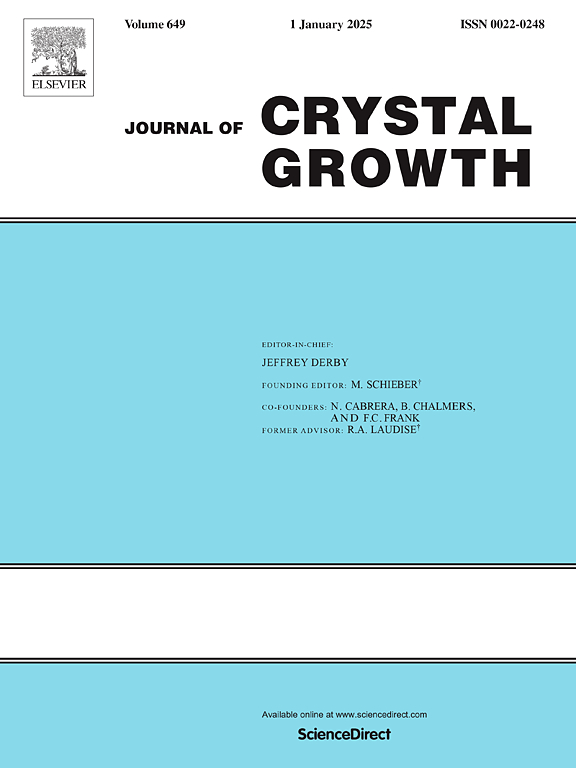低成本制备和表征新型 CuO/ZnO 和 Cu3N/ZnO 纳米复合材料
IF 1.7
4区 材料科学
Q3 CRYSTALLOGRAPHY
引用次数: 0
摘要
通过三步合成法制备了 CuO/ZnO 和 Cu3N/ZnO 纳米复合材料,包括共沉淀 Cu2+ 和 Zn2+ 氢氧化碳酸盐(Cu/Zn-Carb),然后先在空气中进行热处理,再在气态氨中进行热处理。氢氧化碳酸盐的形态和相组成分别由 Cu:Zn 摩尔比和作为封端剂的聚乙烯吡咯烷酮(PVP)的存在决定。铜/锌碳酸盐可以粉末或薄膜形式在 550 °C 的空气中退火。后者可通过旋涂或浸涂技术沉积在硅基底上。在工艺的最后一步,在 300 ℃ 的气态氨下加热所得到的 CuO/ZnO 样品,以形成 Cu3N/ZnO 纳米复合材料。粉末 X 射线衍射(XRD)、扫描电子显微镜(SEM)、透射电子显微镜(TEM)、能量色散 X 射线分析(EDX)、X 射线光电子能谱(XPS)、热重-差热分析(TG-DTA)和红外光谱(IR)对制备的样品进行了表征。SEM 和 XRD 分析表明,球形颗粒的平均直径约为 130 nm(CuO/ZnO)和 100 nm(Cu3N/ZnO),由 10-20 nm 大小的晶粒组成。在空气和 NH3 中进行热处理不会影响复合材料的形态。因此,这意味着 CuO/ZnO 氧化物和 Cu3N/ZnO 氮化物/氧化物复合纳米结构的形状和尺寸在碳酸氢盐共沉淀时就已确定,并可在前驱体合成过程中加以控制。这对可重复制造具有精确化学计量和定制形态的纳米复合薄膜具有重要意义。本文章由计算机程序翻译,如有差异,请以英文原文为准。
Low-cost preparation and characterization of new CuO/ZnO and Cu3N/ZnO nanocomposites
CuO/ZnO and Cu3N/ZnO nanocomposites were prepared in a three-step synthesis consisting of the co-precipitation of Cu2+ and Zn2+ hydroxide carbonates (Cu/Zn-Carb) followed by their thermal treatment first in air and second in gaseous ammonia. The morphology and phase composition of the hydroxide carbonates were determined by the Cu:Zn molar ratio and the presence of polyvinylpyrrolidone (PVP) acting as a capping agent, respectively. The Cu/Zn-carbonates could be annealed in the air at 550 °C either as powders or as thin films. The latter were deposited on a silicon substrate using a choice of spin- or dip-coating techniques. The resulting CuO/ZnO samples were heated under gaseous ammonia at 300 °C in the final step of the process to form Cu3N/ZnO nanocomposites. The fabricated samples were characterized by powder X-ray diffraction (XRD), scanning electron microscopy (SEM), and transmission electron microscopy (TEM) with energy dispersive X-ray analysis (EDX), X-ray photoelectron spectroscopy (XPS), thermogravimetric − differential thermal analysis (TG-DTA) and infrared spectroscopy (IR). SEM and XRD analysis indicates that the average diameter of spherical particles was about 130 nm (CuO/ZnO) and 100 nm (Cu3N/ZnO), composed of crystallites with 10–20 nm sizes. The thermal treatment under air and NH3 did not affect the morphology of the composites. The implication is, therefore, that the shape and size of CuO/ZnO oxide and Cu3N/ZnO nitride/oxide composite nanostructures are determined at the point of hydroxide carbonate coprecipitation and can be controlled during precursor synthesis. This has significant ramifications for the reproducible fabrication of nanocomposite films of precise stoichiometry and bespoke morphology.
求助全文
通过发布文献求助,成功后即可免费获取论文全文。
去求助
来源期刊

Journal of Crystal Growth
化学-晶体学
CiteScore
3.60
自引率
11.10%
发文量
373
审稿时长
65 days
期刊介绍:
The journal offers a common reference and publication source for workers engaged in research on the experimental and theoretical aspects of crystal growth and its applications, e.g. in devices. Experimental and theoretical contributions are published in the following fields: theory of nucleation and growth, molecular kinetics and transport phenomena, crystallization in viscous media such as polymers and glasses; crystal growth of metals, minerals, semiconductors, superconductors, magnetics, inorganic, organic and biological substances in bulk or as thin films; molecular beam epitaxy, chemical vapor deposition, growth of III-V and II-VI and other semiconductors; characterization of single crystals by physical and chemical methods; apparatus, instrumentation and techniques for crystal growth, and purification methods; multilayer heterostructures and their characterisation with an emphasis on crystal growth and epitaxial aspects of electronic materials. A special feature of the journal is the periodic inclusion of proceedings of symposia and conferences on relevant aspects of crystal growth.
 求助内容:
求助内容: 应助结果提醒方式:
应助结果提醒方式:


